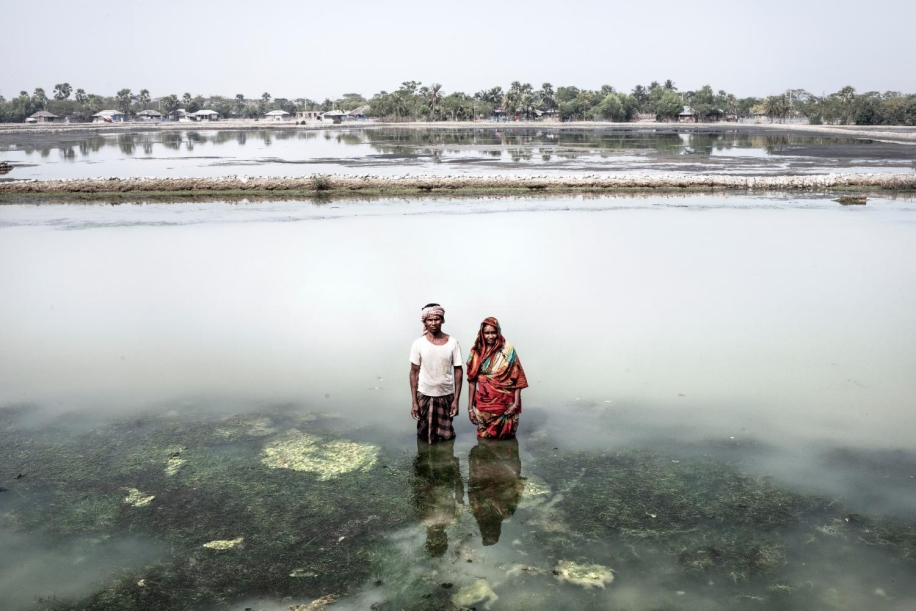

"When my husband goes fishing, I wait for him by the river's edge. I can barely support my husband as I am aging and suffering from diseases. Our children are separated. They have their families and are no longer able to provide for us. The forest is no longer providing us with food. After spending hours in the river, my husband returns with a small number of fish. Every day now, we can hardly sell fish of 80 taka (1USD). When my husband cannot move and falls sick, I do not let him go to the jungle. We starve or eat once. As we grow older, I think we no longer crave food, but we need peace and rest. We have no peace. Water is saltier than ever before; our house is still broken after the cyclone, and now corona is killing us. We have almost no food for the coming days. We remain hungry; we remain thirsty. We have no way to rest or finding peace." - Fatema Khatun & her husband Ruhul Amin Seikh are surviving against all odds at the coast of the Bay of Bengal.
The Last Savings at Bengal Delta
Mohammad Rakibul Hasan | Bangladesh
Photographer: Mohammad Rakibul Hasan
Exhibit Title: The Last Savings at Bengal Delta
Location: Bangladesh
Scientists have forecasted that the seawater would drown the whole coastal belt of Bangladesh around the Sundarbans by 2050. We are working one step ahead to embrace the apocalypse, created for the sake of building worldly wealth, the so-called development of civilization, maneuvering the structure of the earth by supplying to the demand hyper-consumption. The recent data from the Global Carbon Project shows that the highest carbon dioxide-prdoucing countries are China (28%), the United States of America (15%), India (7%), Russia (5%), and Japan (3%) [1]. This culprit gas is causing the world's temperature to rise and bringing adverse climate experiences, which affect human survival and destabilize ecological harmony. The rest of the world only produces 23% carbon while Bangladesh emits non-significant but already has become a scapegoat of the climate crisis.
Bibliography
[1] Global Carbon Project. "Global Carbon Budget 2019," Page 1811. Accessed Nov. 27, 2020.
Arati Biswas, a 70 years old widow who lives at the shore of the Bay of Bengal, doesn't know the "Climate Crisis" and why her food storage is getting shorter day by day. She doesn't even know about global or local economic recession due to Novel Coronavirus spread. Her husband died 35 years ago; she had the only married daughter, and her husband is a street hawker and has three children to feed. Arati lives with her daughter; every day, she makes crackers and walks miles after miles in villages to sell her product as her daughter cannot work due to illness and the daughter's husband has a spinal injury, none of them can earn their living. These crackers are the food by selling she buys food to feed her family. She lives in the world's most catastrophic zone at the world's largest mangrove forest, the Sundarbans, where hundreds of Royal Bengal Tigers nested their home. Still, the frequent cyclones cannot sustain anyone, not humans, animals, or other species. The scientists forecasted that the seawater would drown the whole coastal belt of Bangladesh around the Sundarbans by 2050.
We are one step ahead to embrace the apocalypse for the sake of building worldly wealth, the so-called development of civilization, maneuvering the structure of the earth by supplying to the demand hyper-consumption. The recent data from the Global Carbon Project shows that the top five countries China (28%), the United States of America (15%), India (7%), Russia (5%), and Japan (3%), produce the most of the carbon dioxide [1]. This culprit gas is causing the world's temperature to rise and bringing adverse climate experiences affecting human survival and destabilizing ecological harmony. The rest of the world only produces 23% carbon while Bangladesh emits non-significant but already has become a scapegoat of the climate crisis.
Bibliography
[1] Global Carbon Project. "Global Carbon Budget 2019," Page 1811. Accessed Nov. 27, 2020.
Make Comment/View Comments